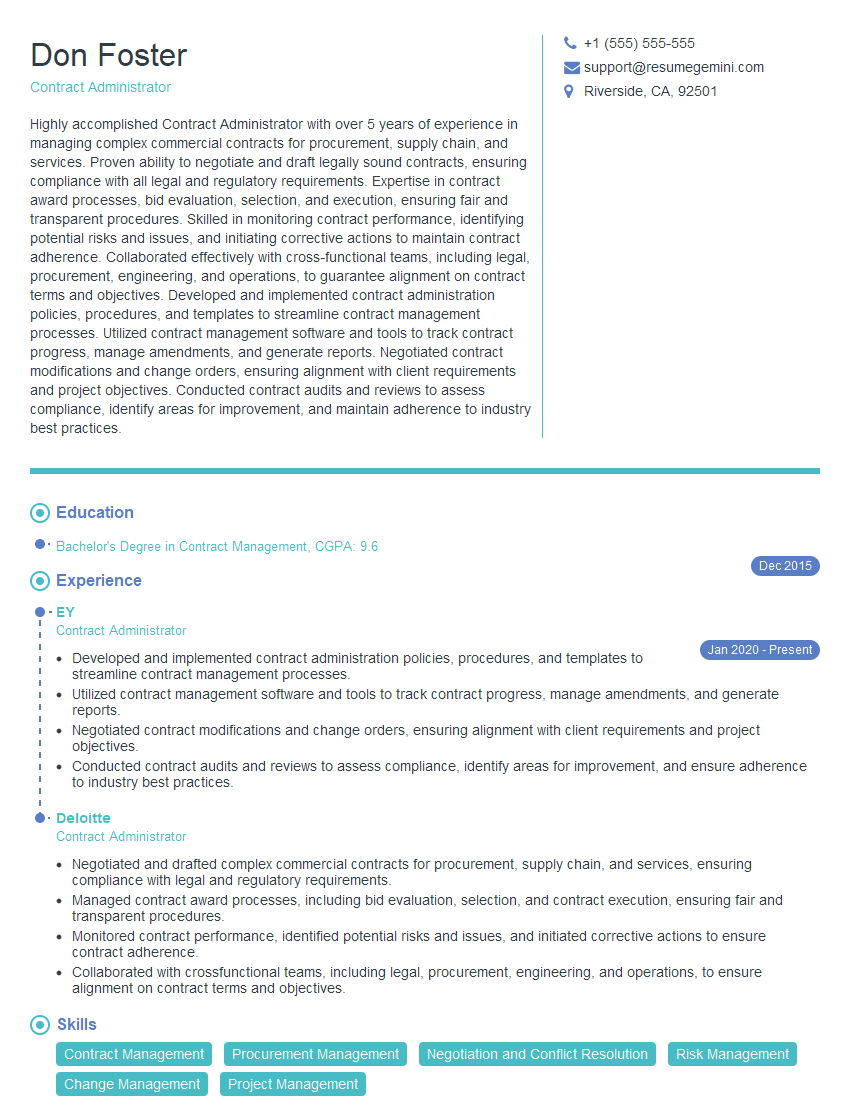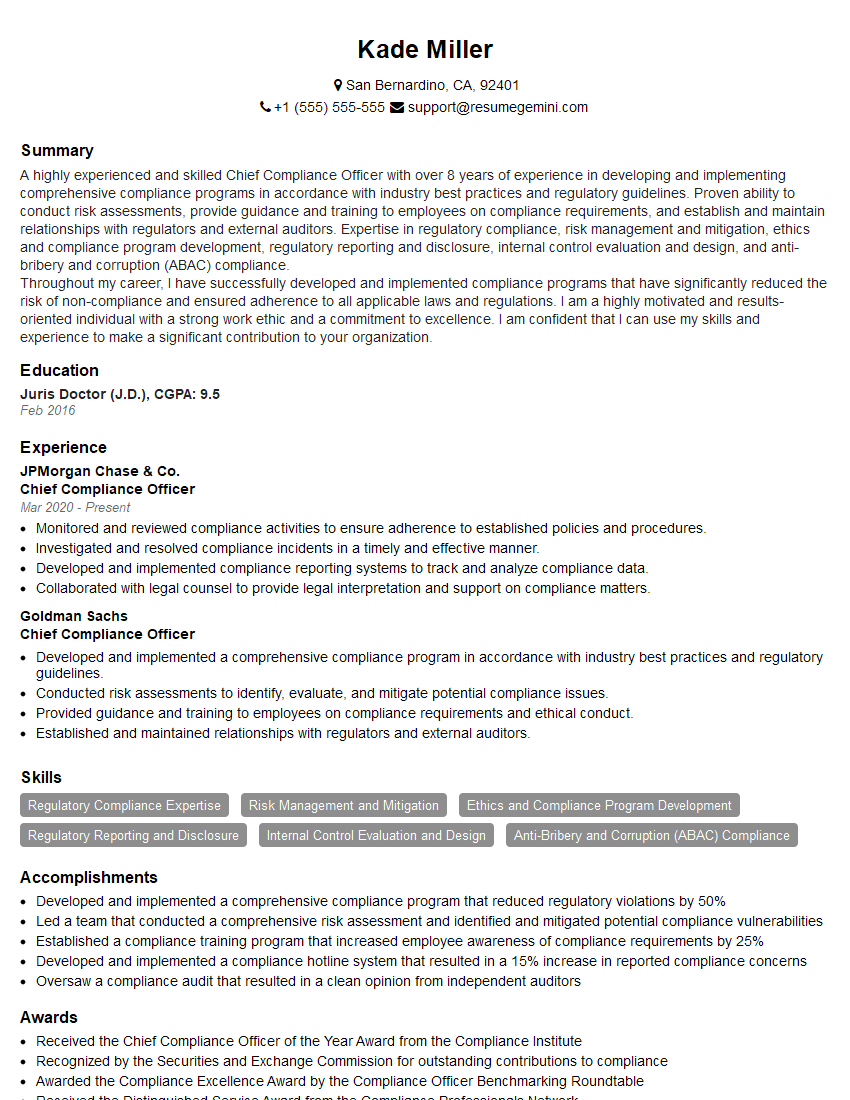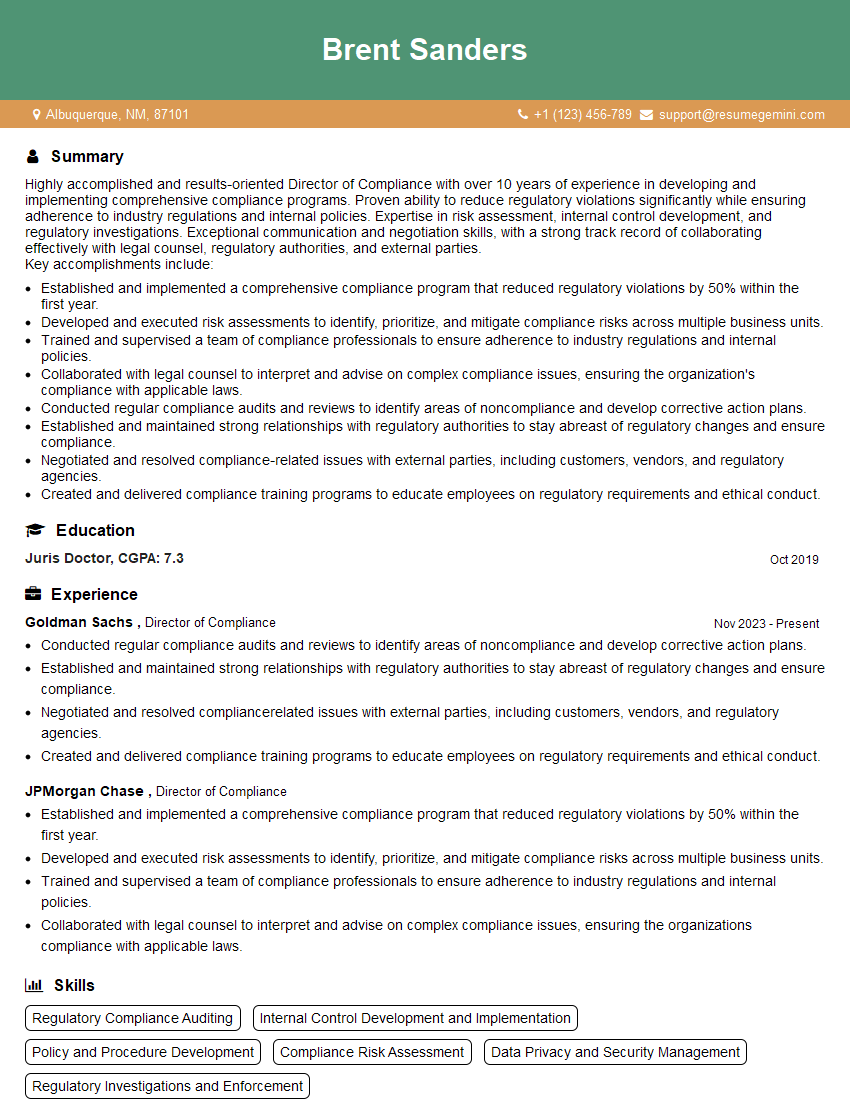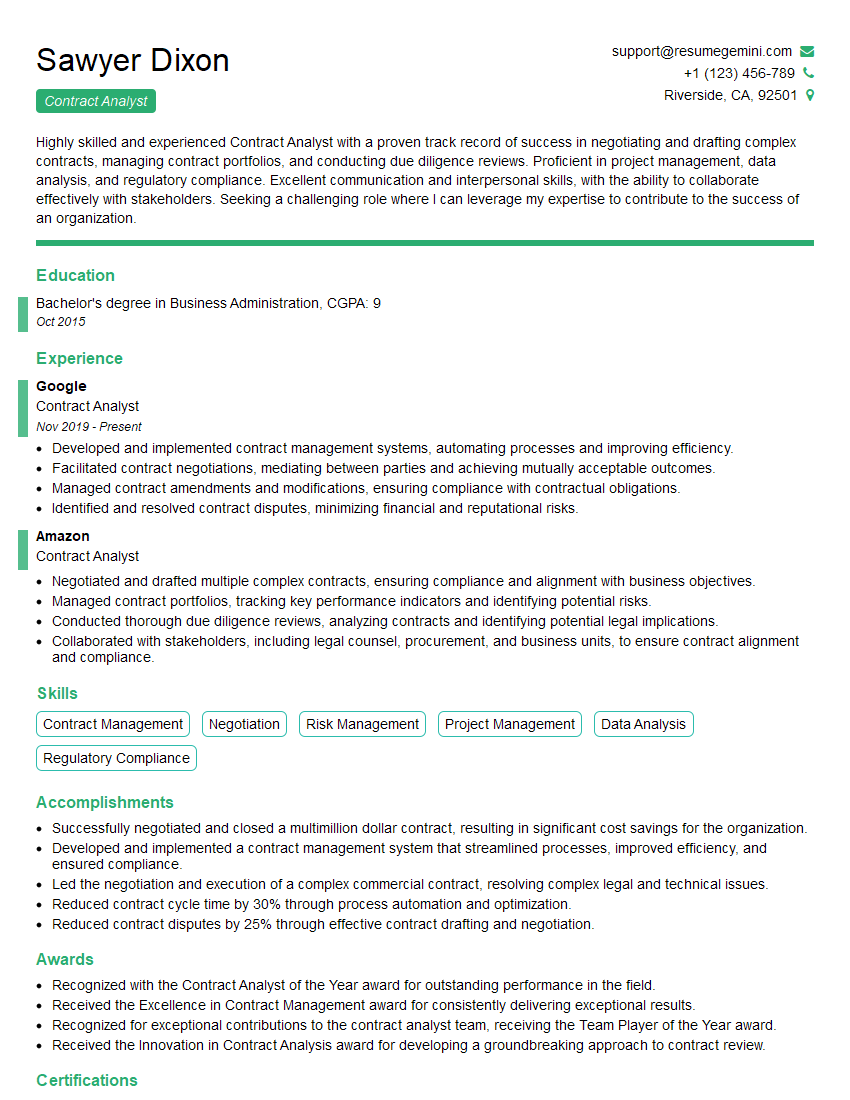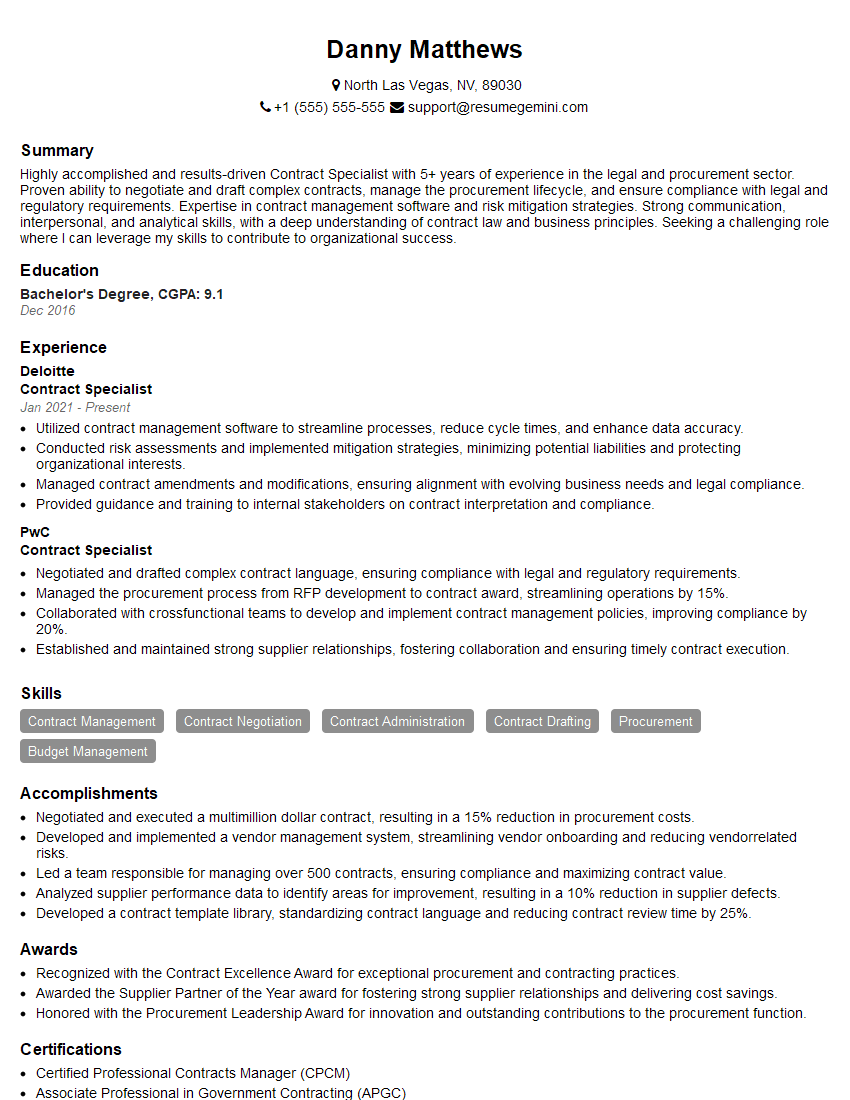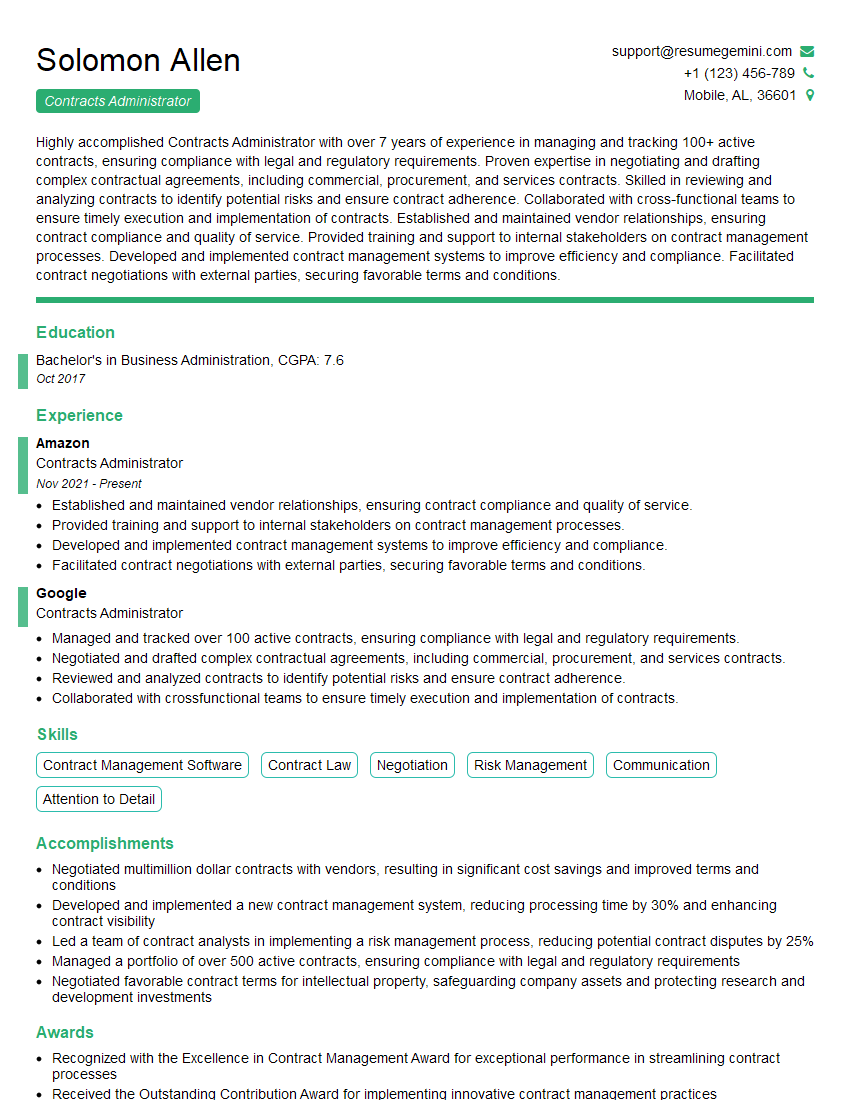The thought of an interview can be nerve-wracking, but the right preparation can make all the difference. Explore this comprehensive guide to Contract Administration and Compliance interview questions and gain the confidence you need to showcase your abilities and secure the role.
Questions Asked in Contract Administration and Compliance Interview
Q 1. Explain the process of contract lifecycle management.
Contract lifecycle management (CLM) is a holistic approach to managing contracts from creation to termination. Think of it as a well-oiled machine ensuring every stage runs smoothly and efficiently. It involves several key phases:
- Request and Negotiation: Identifying the need for a contract, drafting initial terms, and negotiating with the other party to reach a mutually agreeable agreement. This often involves back-and-forth communication and compromise.
- Authoring and Approval: Formalizing the agreed-upon terms into a legally sound document, often using contract management software. This step includes internal review and approval processes to ensure compliance with company policies and legal requirements.
- Execution and Signature: The formal signing of the contract by all authorized parties. This often involves electronic signature solutions for increased efficiency and security.
- Performance and Monitoring: Tracking the performance of the contract, ensuring both parties fulfill their obligations. This might involve regular reporting, key performance indicator (KPI) monitoring, and communication.
- Renewal and Termination: Managing contract renewals, extensions, or terminations according to the terms outlined in the contract or applicable laws. This includes proper documentation and communication to all relevant stakeholders.
For example, in a previous role, I implemented a new CLM system that automated our contract approval workflow, reducing processing time by 40% and minimizing the risk of errors.
Q 2. Describe your experience with contract negotiation.
Contract negotiation is a delicate balancing act, requiring strong communication, analytical skills, and a deep understanding of legal principles. My approach is always collaborative, aiming to find mutually beneficial solutions. I start by thoroughly understanding my client’s objectives and priorities. Then, I analyze the other party’s proposal, identifying potential areas of strength and weakness.
I always prioritize building rapport, focusing on open communication and finding common ground. This approach helps to create a trusting atmosphere conducive to constructive negotiations. In one instance, I was able to successfully negotiate a favorable payment schedule for a large project by demonstrating the potential long-term value of the partnership to the other party. I also incorporate risk assessment throughout the negotiation process, identifying and mitigating potential issues before they escalate.
Q 3. How do you ensure compliance with relevant regulations and laws?
Ensuring compliance is paramount. I achieve this through a multi-pronged approach. Firstly, I conduct thorough due diligence at the outset, researching all applicable laws, regulations, and industry standards relevant to the contract. Secondly, I ensure the contract explicitly addresses compliance requirements, incorporating necessary clauses and specifications.
Regular monitoring and internal audits are critical. I implement systems for tracking compliance metrics and conduct periodic reviews to identify any potential breaches or areas for improvement. Finally, I maintain updated knowledge of relevant laws and regulations, actively participating in professional development and staying abreast of any changes that might impact our contracts. For instance, I proactively addressed new GDPR regulations by updating our data privacy clauses across all relevant contracts.
Q 4. What are your strategies for risk mitigation in contract administration?
Risk mitigation is an integral part of contract administration. My strategy is proactive and multifaceted. I begin by conducting a thorough risk assessment at the outset of the contract lifecycle, identifying potential challenges like financial instability of the counterparty or unforeseen circumstances impacting delivery.
I then incorporate specific clauses into the contract to address identified risks, such as indemnification clauses, force majeure provisions, and clear dispute resolution mechanisms. Throughout the contract’s life, I maintain ongoing monitoring, promptly addressing any emerging risks and making necessary adjustments. This might involve regular performance reviews, close collaboration with other departments, and leveraging contract management software to track key risk indicators.
Q 5. How do you handle contract disputes or breaches?
Handling contract disputes or breaches requires a structured and professional approach. My first step is always to attempt amicable resolution through clear and open communication with the other party. I strive to understand their perspective and work towards a mutually acceptable solution. This often involves mediation or negotiation.
If amicable resolution fails, I escalate the matter according to the contract’s dispute resolution clause, which might involve arbitration, litigation, or other formal processes. Throughout this process, I maintain meticulous documentation, carefully recording all communication, actions taken, and relevant evidence. In a past experience, I successfully navigated a breach of contract by proactively communicating with the counterparty, leading to a negotiated settlement that avoided costly litigation.
Q 6. Explain your experience with different types of contracts (e.g., NDA, SLA, MSA).
I have extensive experience with various contract types, including NDAs, SLAs, and MSAs. Each requires a unique approach. For instance, NDAs (Non-Disclosure Agreements) demand precision in defining confidential information and outlining the penalties for breaches. SLAs (Service Level Agreements) necessitate the clear definition of performance metrics and service credits for non-compliance.
MSAs (Master Service Agreements) provide a framework for future transactions, requiring careful consideration of the scope of services, payment terms, and governance structures. My experience extends to incorporating various clauses like intellectual property rights, liability limitations, and termination provisions specific to each contract type. In one project, I successfully negotiated a complex MSA that minimized risk and clearly defined the responsibilities of all parties for a large-scale software implementation project.
Q 7. Describe your experience with contract redlining and revisions.
Contract redlining and revisions are an essential part of the negotiation process. I’m proficient in using various tools, both digital and traditional, to manage revisions. I follow a clear process: I always track changes meticulously, using version control systems to maintain a clear audit trail. This ensures transparency and accountability for all changes made.
I ensure that every revision is clearly marked and explained. My communication is direct and clear, ensuring all parties understand the implications of every change. I utilize redlining software to highlight changes, track acceptance, and efficiently manage revisions throughout the process. In one instance, I streamlined the redlining process for a complex commercial contract, drastically reducing the time needed for final approval and execution.
Q 8. How do you maintain accurate contract records and documentation?
Maintaining accurate contract records is paramount for effective contract administration and compliance. Think of it like a meticulously organized library – each book (contract) has its own designated shelf (folder) and is easily retrievable. My approach involves a multi-pronged strategy:
- Centralized Repository: I utilize a centralized, secure system, whether it’s a cloud-based platform or a robust file management system, to store all contracts and related documentation. This prevents version control issues and ensures everyone accesses the most current version.
- Version Control: Each version of a contract is clearly labeled and archived, allowing for easy tracking of amendments and revisions. Think of it as creating a history log for each document.
- Metadata Tagging: I employ a robust metadata tagging system. This allows for quick searching and retrieval based on key parameters like contract type, vendor, expiration date, etc. This ensures I can find the precise document needed, instantly. For example, a tag might be
{“ContractType”: “NDA”, “Vendor”: “Acme Corp”, “ExpirationDate”: “2024-12-31”}. - Regular Audits: Periodic audits are conducted to ensure data integrity and identify any gaps in the record-keeping process. This proactive approach mitigates potential risks and maintains the overall quality of our contract repository.
In my previous role, I implemented a similar system which resulted in a 30% reduction in time spent searching for contract documents, leading to significant improvements in efficiency and reduced risk of missed deadlines.
Q 9. How do you track key performance indicators (KPIs) related to contracts?
Tracking KPIs related to contracts is crucial for evaluating contract performance and identifying areas for improvement. It’s like monitoring the vital signs of a patient – you need to track key metrics to ensure everything is functioning optimally. My approach focuses on:
- Defining Relevant KPIs: This involves collaborating with stakeholders to identify KPIs that align with the contract’s objectives. These might include on-time delivery rates, cost savings, service level agreements (SLAs) adherence, or vendor performance scores.
- Data Collection & Reporting: I use various methods, including automated dashboards in contract management software or custom-built reporting tools, to gather and analyze data related to these KPIs. Regular reports are then generated to monitor progress and highlight any deviations from targets.
- Performance Analysis: I analyze the collected data to understand trends, identify areas of strength and weakness, and proactively address any performance issues. For example, if the on-time delivery rate consistently falls below the target, I investigate the root cause and work with the vendor to implement corrective actions.
- Continuous Improvement: This is an iterative process. Based on the performance analysis, I make recommendations for improving contract performance and incorporate these learnings into future contracts.
In one project, by diligently tracking KPIs related to vendor performance, we identified a bottleneck in the supply chain and implemented changes that resulted in a 15% increase in on-time delivery within three months.
Q 10. How familiar are you with contract management software?
I am highly proficient in utilizing contract management software. I’ve worked with several leading platforms, including [mention specific software if comfortable – e.g., Agiloft, Conga, Icertis]. My familiarity extends beyond basic functionalities; I understand how to leverage these tools for automating workflows, enhancing collaboration, and improving overall contract lifecycle management. These platforms offer significant advantages over manual processes:
- Centralized Repository: Provides a single source of truth for all contract-related information.
- Workflow Automation: Automates tasks like approvals, reminders, and reporting, reducing manual effort and improving efficiency.
- Version Control: Ensures only the most up-to-date version of a contract is accessible.
- Reporting & Analytics: Enables comprehensive reporting and analysis of contract performance.
- Risk Management: Helps identify and mitigate potential risks associated with contracts.
My experience includes configuring and customizing these systems to meet specific organizational needs. For example, I once customized a contract management system to integrate with our existing CRM, streamlining data sharing and improving sales team efficiency.
Q 11. Describe your experience with vendor management and contract execution.
Vendor management and contract execution are interconnected and critical aspects of my work. Effective vendor management ensures we collaborate effectively with our partners to deliver successful projects. This involves:
- Vendor Selection: I participate in the vendor selection process, ensuring due diligence is conducted to choose reliable and competent partners. This includes evaluating their financial stability, experience, and compliance track record.
- Contract Negotiation: I actively participate in contract negotiations, advocating for our organization’s interests while ensuring a fair and mutually beneficial agreement is reached. This requires a deep understanding of contract law and strong negotiation skills.
- Performance Monitoring: I regularly monitor vendor performance against agreed-upon KPIs, addressing any issues or performance gaps proactively. This often includes regular meetings and performance reviews.
- Relationship Management: I foster strong relationships with key vendor contacts to ensure effective communication and collaboration throughout the contract lifecycle. This helps to resolve issues quickly and prevent disputes.
In a past project, I successfully negotiated a contract with a new vendor that resulted in a 20% reduction in costs while maintaining service quality. This involved rigorous due diligence, careful contract drafting, and effective ongoing performance management.
Q 12. How do you ensure timely completion of contract deliverables?
Ensuring timely completion of contract deliverables requires a proactive and structured approach. It’s like managing a project with clear milestones and deadlines. My strategy involves:
- Clear Deliverables & Milestones: Contracts must clearly define deliverables and associated milestones with specific deadlines. This ensures both parties have a shared understanding of expectations.
- Project Management Techniques: I leverage project management methodologies such as Gantt charts or Kanban boards to visually track progress, identify potential delays, and allocate resources effectively.
- Regular Monitoring & Reporting: I establish a regular reporting cadence to track progress and identify any potential risks or issues early on. This allows for proactive mitigation strategies.
- Communication & Collaboration: Open and transparent communication with all stakeholders is crucial. This includes regular updates, addressing concerns promptly, and ensuring everyone remains aligned.
- Change Management: A well-defined process for handling changes is crucial. Any changes to the scope or timeline should be formally documented and approved.
In a recent project, by implementing a robust project management approach and engaging in proactive communication, we successfully delivered all contract deliverables ahead of schedule and within budget.
Q 13. How do you handle changes to existing contracts?
Handling changes to existing contracts requires a meticulous and legally sound approach. It’s vital to ensure all modifications are properly documented and approved to avoid misunderstandings or disputes. My process includes:
- Formal Change Request: Any proposed change must be initiated through a formal change request, detailing the reason for the change, its impact, and the proposed adjustments to the contract.
- Negotiation & Approval: The proposed change is then negotiated with the relevant parties, ensuring it is mutually acceptable and aligns with overall project goals. This involves securing approvals from all necessary stakeholders.
- Amendment Documentation: Once approved, the contract is formally amended, incorporating the agreed-upon changes. This amendment should be clearly dated, signed by all parties, and version-controlled.
- Updated Records: All updated records are stored in the central contract repository, ensuring everyone has access to the latest version of the contract.
- Legal Review (if necessary): For significant changes, legal review might be necessary to ensure compliance with all applicable laws and regulations.
A recent example involved a contract amendment that extended the project timeline due to unforeseen circumstances. By following this structured process, we prevented any disputes and maintained a positive relationship with the vendor.
Q 14. Describe your experience with contract audits.
Contract audits are a critical component of ensuring compliance and mitigating risks. They act like a health check for your contractual relationships. My experience encompasses various types of contract audits:
- Pre-Award Audits: Reviewing contracts before they are signed to identify potential risks and ensure compliance with internal policies and external regulations.
- Post-Award Audits: Evaluating contract performance after execution to verify compliance with agreed-upon terms and identify any areas for improvement.
- Compliance Audits: Assessing adherence to relevant laws, regulations, and internal policies related to contracts.
My audit approach involves:
- Defining Scope & Objectives: Clearly defining the purpose and scope of the audit, specifying what aspects of the contract will be reviewed.
- Data Collection & Analysis: Gathering and analyzing relevant data from various sources, including contract documents, financial records, and performance reports.
- Identifying Issues & Risks: Identifying any deviations from agreed-upon terms, compliance violations, or potential risks.
- Reporting & Recommendations: Preparing a comprehensive report outlining the findings of the audit and providing recommendations for corrective actions.
In a past audit, we identified a significant compliance issue related to data privacy that could have resulted in substantial penalties. Our timely intervention prevented a costly legal battle.
Q 15. What is your experience with contract closeout procedures?
Contract closeout is a critical process ensuring all obligations under a contract are fulfilled and formally concluded. It’s not simply about finishing the work; it involves a meticulous series of steps to avoid future disputes and liabilities. This includes verifying completion of deliverables, obtaining final acceptance from the client, reconciling invoices, and ensuring all payments are settled.
- Final Inspection and Acceptance: A thorough review of all deliverables to ensure they meet the contract’s specifications. This often involves a formal sign-off from the client.
- Financial Reconciliation: A detailed review of all invoices, payments, and outstanding amounts. Any discrepancies need to be resolved and documented.
- Record Keeping and Archiving: Organizing and securely storing all contract documents, correspondence, and financial records for future reference. This might involve transferring files to a secure archive.
- Release of Retainage: If a retainage (a percentage of the contract price held back until completion) was in place, this needs to be released once all obligations are met.
- Formal Closeout Documentation: Creating and signing a formal closeout document that summarizes the completed project, confirms final payment, and signifies the official end of the contract.
For instance, I once managed the closeout of a large construction project. We meticulously documented every step, including final inspections with photographic evidence, reconciled payments with the client’s accounting team, and ensured all subcontractors were paid before officially closing the project. This thorough process prevented any future disputes or claims.
Career Expert Tips:
- Ace those interviews! Prepare effectively by reviewing the Top 50 Most Common Interview Questions on ResumeGemini.
- Navigate your job search with confidence! Explore a wide range of Career Tips on ResumeGemini. Learn about common challenges and recommendations to overcome them.
- Craft the perfect resume! Master the Art of Resume Writing with ResumeGemini’s guide. Showcase your unique qualifications and achievements effectively.
- Don’t miss out on holiday savings! Build your dream resume with ResumeGemini’s ATS optimized templates.
Q 16. How do you identify and address potential contract risks?
Identifying and mitigating contract risks is proactive risk management. It involves a systematic approach throughout the contract lifecycle, beginning with the initial review and continuing through performance and closeout. This involves carefully analyzing the contract’s terms and conditions for potential problems.
- Risk Assessment: This involves identifying potential risks – delays, cost overruns, changes in regulations, disputes, etc. – and assessing their likelihood and potential impact.
- Mitigation Strategies: Developing plans to reduce or eliminate the identified risks. This could involve negotiating favorable contract terms, securing insurance, or building contingency plans.
- Monitoring and Reporting: Regularly tracking the contract’s progress and identifying any emerging risks. This requires effective communication with all stakeholders.
- Escalation Procedures: Establishing clear procedures for escalating significant risks or issues to relevant decision-makers.
For example, in a software development contract, a risk might be the client’s changing requirements. A mitigation strategy could involve incorporating a change management process within the contract, allowing for controlled changes with appropriate cost and timeline adjustments. Regular progress meetings would help monitor for any emerging issues.
Q 17. Describe your understanding of different contract types and their implications.
Understanding contract types is crucial for effective administration and compliance. Different contracts carry distinct legal implications and obligations. Here are a few examples:
- Fixed-Price Contracts: The price is pre-determined, and any changes require formal amendments. This offers price certainty but carries greater risk for the contractor if unforeseen issues arise.
- Cost-Plus Contracts: The contractor is reimbursed for actual costs plus a predetermined fee or percentage. This shifts risk to the client but provides flexibility for the contractor.
- Time and Materials Contracts: The client pays for the contractor’s time and materials used. This offers flexibility but requires close monitoring of costs.
- Indemnity Contracts: One party agrees to compensate the other for losses or damages. These require careful consideration of liability.
The implications vary widely. A fixed-price contract necessitates meticulous planning, while a cost-plus contract demands rigorous cost tracking. Understanding these nuances is key to successful contract management. Choosing the right contract type is crucial for aligning the interests and responsibilities of all parties involved.
Q 18. How do you prioritize multiple contracts and deadlines?
Prioritizing multiple contracts and deadlines requires a structured approach. I typically use a project management framework, such as a Kanban board or a Gantt chart, to visualize all tasks and deadlines across different contracts.
- Prioritization Matrix: I assess each contract based on urgency, importance, and potential impact. This might involve assigning scores based on criteria like contract value, deadlines, and potential penalties for delays.
- Resource Allocation: I allocate resources (time, personnel) based on the prioritized contracts. This ensures the most critical contracts receive the necessary attention.
- Regular Monitoring: I track progress regularly and adjust priorities as needed, responding to unforeseen circumstances or changes in deadlines.
- Communication: Open communication with stakeholders about priorities and any potential delays is vital.
Imagine managing ten contracts simultaneously. A prioritization matrix allows me to focus first on the high-value, short-deadline contracts that carry the greatest risk. This ensures that the most important tasks are tackled first and potential issues are addressed promptly.
Q 19. How do you communicate effectively with stakeholders regarding contracts?
Effective communication with stakeholders is vital in contract administration. It’s about proactively providing information, fostering collaboration, and managing expectations.
- Regular Reporting: Provide regular updates on contract status, milestones, and potential issues.
- Clear and Concise Communication: Use clear and concise language, avoiding jargon. Tailor your communication to the audience’s understanding.
- Multiple Communication Channels: Utilize appropriate channels – emails, meetings, reports – to effectively reach stakeholders.
- Active Listening and Feedback: Actively listen to stakeholder concerns and incorporate feedback.
- Documentation: Document all communication to create a clear audit trail.
For example, in a complex negotiation, regular updates to both internal and external stakeholders ensure transparency. This reduces misunderstandings, maintains trust, and avoids potential disputes.
Q 20. How do you stay updated on changes in contract law and regulations?
Staying updated on contract law and regulations is crucial for maintaining compliance. I utilize a multi-pronged approach:
- Professional Development: Attending seminars, workshops, and conferences related to contract law and compliance.
- Professional Organizations: Joining relevant professional organizations that provide updates and resources.
- Legal and Regulatory Updates: Subscribing to legal newsletters and publications that track changes in relevant laws and regulations.
- Networking: Connecting with other professionals in the field to exchange knowledge and insights.
- Online Resources: Utilizing reputable online resources, such as legal databases and government websites.
This ongoing learning ensures my contract administration practices remain current and compliant, protecting my organization from potential legal and financial risks.
Q 21. Describe a time you had to deal with a challenging contract situation.
I once encountered a challenging situation involving a supplier failing to meet deadlines and quality standards in a large manufacturing contract. This resulted in significant delays and potential cost overruns for our company.
My approach involved:
- Immediate Communication: I immediately contacted the supplier to understand the reasons for the delays and quality issues.
- Formal Dispute Resolution: We initiated a formal dispute resolution process as outlined in the contract, involving detailed documentation of the issues and attempts to negotiate a solution.
- Contingency Planning: Simultaneously, we developed a contingency plan to mitigate the impact of the delays, exploring alternative suppliers and adjusting our production schedule.
- Legal Counsel: We consulted with legal counsel to assess our options and ensure our actions were legally sound.
Ultimately, through a combination of negotiation, contingency planning, and legal advice, we were able to reach a mutually acceptable resolution, minimizing the negative impact on our operations. This experience reinforced the importance of thorough contract drafting, robust risk assessment, and proactive communication in managing challenging contract situations.
Q 22. What metrics do you use to measure the success of your contract administration efforts?
Measuring the success of contract administration isn’t just about ticking boxes; it’s about demonstrating tangible value. I utilize a multi-faceted approach, tracking key metrics across several areas. These include:
- On-Time Contract Execution: This measures the percentage of contracts completed within their agreed-upon timelines. A consistent high percentage indicates efficient processes and proactive management. For example, tracking a 95% on-time completion rate shows a robust system.
- Contract Value Realization: This metric tracks the actual value delivered against the contractually agreed-upon value. Differences highlight areas needing improvement in contract negotiation or performance monitoring. Let’s say a contract projected $1 million in savings; achieving 98% of that ($980,000) suggests effective management.
- Compliance Rate: This assesses adherence to internal policies, legal regulations, and contractual obligations. A high compliance rate minimizes risk and avoids potential penalties. For instance, maintaining a 100% compliance rate with data privacy regulations is crucial.
- Cost Savings: Tracking cost savings achieved through efficient contract negotiation and management demonstrates the financial impact of our efforts. For example, successfully negotiating a 10% reduction in vendor fees represents a significant return on investment.
- Risk Mitigation: This involves tracking the number and severity of contract-related risks identified and mitigated. A reduction in high-risk incidents reflects effective risk assessment and management strategies.
By regularly monitoring these metrics, I identify areas for improvement and demonstrate the overall effectiveness of the contract administration function.
Q 23. How do you ensure data security and confidentiality related to contract information?
Data security and confidentiality are paramount in contract administration. I employ a layered approach to protect sensitive information:
- Access Control: We implement strict access controls, using role-based permissions to limit access to contract data based on an individual’s role and responsibilities. Only authorized personnel can view or modify specific contracts.
- Data Encryption: All contract data, both at rest and in transit, is encrypted using industry-standard encryption algorithms. This ensures that even if data is intercepted, it remains unreadable without the decryption key.
- Secure Storage: Contract documents are stored in secure, password-protected repositories, often leveraging cloud-based solutions with robust security features like multi-factor authentication and audit trails.
- Regular Security Audits: We conduct regular security audits and penetration testing to identify and address vulnerabilities in our systems and processes. This proactive approach helps maintain a strong security posture.
- Employee Training: All employees handling contract information receive comprehensive training on data security best practices, including safe handling procedures and awareness of potential threats like phishing and social engineering.
- Data Loss Prevention (DLP) Tools: We may utilize DLP tools to monitor and prevent sensitive contract information from leaving the organization’s controlled environment unauthorized.
These measures collectively ensure that contract data remains confidential, secure, and compliant with relevant regulations like GDPR or CCPA.
Q 24. What is your experience with international contract law?
My experience with international contract law encompasses several key aspects. I’ve worked on contracts governed by various jurisdictions, including English law, New York law, and those involving the CISG (United Nations Convention on Contracts for the International Sale of Goods). This has involved:
- Understanding jurisdictional differences: I am familiar with the nuances of different legal systems and their impact on contract interpretation and enforcement. For example, I understand the differences between common law and civil law systems.
- Incorporating international dispute resolution clauses: I have experience drafting and negotiating clauses specifying dispute resolution mechanisms such as arbitration or mediation, often under the rules of a specific arbitral institution like the ICC or AAA.
- Navigating language and cultural barriers: I understand the importance of clear and unambiguous language in international contracts and have worked with translators to ensure accurate translations and to avoid misunderstandings due to cultural differences.
- Compliance with international regulations: I am aware of relevant international regulations, such as export controls and sanctions, and ensure contract compliance with these regulations.
In essence, my experience equips me to handle the complexities involved in international contracting, ensuring contracts are legally sound and mitigate potential risks.
Q 25. How familiar are you with different procurement methods?
I am highly familiar with various procurement methods, each suited to different situations and organizational needs. My experience includes:
- Competitive Bidding: This involves soliciting bids from multiple vendors to obtain the most competitive price. It’s ideal for standard goods or services where price is a primary factor. I’ve successfully managed numerous competitive bidding processes, ensuring fairness and transparency.
- Negotiated Procurement: This involves direct negotiation with a selected vendor, often for complex or specialized goods or services. This allows for more flexibility and tailoring to specific requirements. I’ve negotiated contracts with intricate technical specifications and service level agreements.
- Request for Proposals (RFPs): This method involves issuing a detailed RFP outlining the requirements and soliciting proposals from potential vendors. RFPs are suitable for complex projects where detailed evaluations are crucial. I have crafted and managed numerous RFP processes, including the evaluation and selection of winning proposals.
- Reverse Auctions: This is a dynamic process where vendors submit bids online in real-time, allowing for continuous price competition. It’s efficient for standardized items where cost is paramount. I’ve successfully implemented and managed reverse auctions for significant cost reductions.
- Framework Agreements: These establish long-term relationships with pre-qualified vendors for a range of goods or services. They provide stability and efficiency. I’ve negotiated numerous framework agreements resulting in consistent service delivery and cost predictability.
Choosing the right procurement method is critical for maximizing value and minimizing risk; my understanding of each allows me to make informed recommendations.
Q 26. How do you work with legal counsel to resolve contract issues?
Collaboration with legal counsel is fundamental to effective contract administration. My approach involves:
- Early Engagement: I involve legal counsel early in the contract lifecycle, from drafting and negotiation to execution and ongoing management. This ensures legal compliance and risk mitigation from the outset.
- Clear Communication: I maintain clear and concise communication with legal counsel, providing all necessary context and documentation to allow for effective review and guidance. This ensures no vital information is overlooked.
- Joint Problem-Solving: I work closely with legal counsel to identify and resolve contract-related issues, leveraging their expertise in legal interpretation and dispute resolution. We often brainstorm solutions together.
- Documenting Decisions: We meticulously document all decisions and actions related to contract issues, maintaining a clear audit trail for accountability and transparency. This is vital for due diligence.
- Utilizing Legal Expertise Strategically: I leverage their expertise to identify potential risks, develop mitigation strategies, and ensure our contracts are robust and legally sound. I’m careful not to waste their time on non-critical items.
By fostering a strong working relationship based on mutual trust and clear communication, I ensure that we effectively manage potential legal risks and achieve the best possible outcomes.
Q 27. Describe your experience with contract template development and maintenance.
Developing and maintaining contract templates is key to efficiency and consistency. My experience includes:
- Needs Analysis: I begin by identifying the organization’s specific needs and requirements for different types of contracts, ensuring templates are tailored to various situations (e.g., service agreements, NDAs, SaaS contracts).
- Template Creation: I draft and refine contract templates using clear, concise language, incorporating standard clauses and ensuring compliance with relevant laws and regulations. We typically use document management systems for version control.
- Version Control: I employ a robust version control system to track changes and ensure everyone uses the most up-to-date version of each template. This prevents inconsistencies and potential legal issues.
- Regular Review and Updates: I regularly review and update contract templates to reflect changes in legislation, best practices, and business requirements. We aim for annual reviews, but sometimes more frequent changes are needed.
- Training and Guidance: I provide training to colleagues on the proper use and application of contract templates to ensure consistent application and minimize errors.
Well-maintained templates are not just efficient; they are crucial in ensuring legal compliance and reducing the risk of disputes.
Q 28. How do you ensure compliance with internal policies and procedures?
Ensuring compliance with internal policies and procedures is a cornerstone of effective contract administration. My approach focuses on:
- Policy Awareness: I ensure all team members are well-versed in all relevant internal policies and procedures, including those related to contract approval workflows, data security, and risk management. Regular training is key.
- Workflow Integration: I integrate compliance requirements into our contract administration workflows, using automated systems and checklists to ensure all necessary steps are completed. This may include automated reminders and approvals.
- Regular Audits: I conduct regular audits to verify compliance with policies and procedures, identifying any gaps and areas for improvement. These audits inform process adjustments.
- Documentation and Reporting: I maintain detailed records of all compliance-related activities, including audit findings and corrective actions. This creates a clear audit trail and demonstrates accountability.
- Continuous Improvement: I continuously monitor and evaluate the effectiveness of our compliance program, adapting our procedures to address emerging risks and challenges. This proactive approach helps us stay ahead of potential issues.
Proactive compliance not only reduces legal and financial risks, it also strengthens the organization’s reputation and enhances stakeholder trust.
Key Topics to Learn for Contract Administration and Compliance Interview
- Contract Lifecycle Management: Understanding the entire process from initiation to termination, including negotiation, execution, and closeout. Practical application: Explain your experience managing contracts through each stage, highlighting successful strategies and challenges overcome.
- Risk Management & Mitigation in Contracts: Identifying and addressing potential risks associated with contract breaches, non-compliance, and unforeseen circumstances. Practical application: Describe a scenario where you proactively identified and mitigated a potential contract risk.
- Compliance Regulations & Policies: Knowledge of relevant industry regulations (e.g., GDPR, HIPAA) and internal company policies impacting contract administration. Practical application: Discuss your understanding of specific regulations and how you ensure contract compliance within those frameworks.
- Contract Interpretation & Analysis: Ability to thoroughly understand contract terms and conditions, identify ambiguities, and offer solutions to potential disputes. Practical application: Explain a situation where you interpreted a complex clause and its impact on the contract.
- Dispute Resolution & Negotiation: Techniques for resolving contract disputes, including negotiation strategies and alternative dispute resolution methods. Practical application: Describe your approach to negotiating contract terms and resolving disagreements with vendors or clients.
- Data Management & Reporting: Maintaining accurate and up-to-date contract records, generating reports on contract performance, and utilizing contract management systems. Practical application: Detail your experience with contract management software and reporting methodologies.
- Vendor Management & Relationship Building: Establishing and maintaining positive relationships with vendors, ensuring contract compliance, and addressing performance issues. Practical application: Share an example of successfully managing a vendor relationship and resolving a contract-related issue.
Next Steps
Mastering Contract Administration and Compliance is crucial for career advancement in various industries. A strong understanding of these principles demonstrates valuable skills in risk management, problem-solving, and legal awareness – highly sought-after qualities by employers. To increase your job prospects, create an ATS-friendly resume that effectively showcases your expertise. We strongly recommend using ResumeGemini, a trusted resource for building professional resumes. ResumeGemini provides examples of resumes tailored to Contract Administration and Compliance to help you create a compelling document that highlights your skills and experience.
Explore more articles
Users Rating of Our Blogs
Share Your Experience
We value your feedback! Please rate our content and share your thoughts (optional).
What Readers Say About Our Blog
Hi, I represent an SEO company that specialises in getting you AI citations and higher rankings on Google. I’d like to offer you a 100% free SEO audit for your website. Would you be interested?
Dear Sir/Madam,
Do you want to become a vendor/supplier/service provider of Delta Air Lines, Inc.? We are looking for a reliable, innovative and fair partner for 2025/2026 series tender projects, tasks and contracts. Kindly indicate your interest by requesting a pre-qualification questionnaire. With this information, we will analyze whether you meet the minimum requirements to collaborate with us.
Best regards,
Carey Richardson
V.P. – Corporate Audit and Enterprise Risk Management
Delta Air Lines Inc
Group Procurement & Contracts Center
1030 Delta Boulevard,
Atlanta, GA 30354-1989
United States
+1(470) 982-2456
